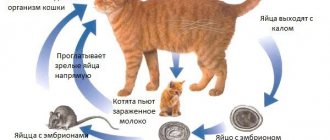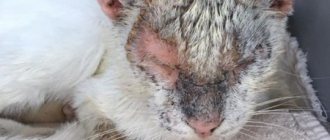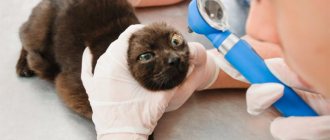Calcivirosis in cats is a contagious respiratory disease that causes inflammatory changes in the upper respiratory tract, conjunctiva of the eyes and oral cavity. Pathogen is a ribonucleic acid that includes a microbe (genus Vesivirus) from the genus Caliciviridae. An infectious scout does not contain a personal shell, has the ability to reproduce inside a cell, and causes the appearance of a special virus of neutralizing antibodies.
In 1957, the South American virologist Foster was the first to identify and describe the virus. The microbe is not stable in the external environment, in conditions of moderate moisture it retains pathogenic qualities for up to 10 days, in dry soil - no more than 2 days, is sensitive to high temperatures (it dies within 30 minutes at temperatures above 50 degrees), methanol and bleach solution. Does not lose its energy when exposed to acidic environments, chloroform, ether.
Susceptibility
Content
The disease is known in many countries of the world. Cats of all age groups and breeds are susceptible to calcivirus. Greater susceptibility to infection is observed in kittens up to three months. For them it is acute, quite intense, and quickly leads to death. Mature cats are characterized by the transition of diseases to the chronic stage.
The causes of the risk are considered to be reduced immunity as a result of other, recently suffered diseases, and incorrect vaccination or its inaccessibility.
In closed households, calcivirosis occurs in cats quite rarely. The incidence of disease between animals kept in kennels is much higher. The maximum circulation of the infectious agent is recorded in autumn and winter.
What is calcivirus in cats and why is it dangerous?
The causative agent of the disease is a small virus of the Caliciviridae family, consisting of a single strand of RNA - Feline Calicivirus (FCV). It is somewhat similar in effect to the human influenza virus, affecting the upper respiratory tract and oral cavity, causing infection. This is the most common infectious agent of respiratory diseases.
The lifespan of the virus in a humid environment is up to 10 days, in a dry environment - about 2-3 days. It is resistant to heat and disinfectants, solutions of chloramine, chloroform, ether, and also withstands all fluctuations in pH levels up to 4. In the area where the sick cat lived and the objects with which it came into contact, the virus persists for up to 7 days. All street cats are at risk, as well as domestic unvaccinated pets and animals that often attend exhibitions. Kittens and young cats under 2 years of age are most susceptible to the disease.
The spread of the disease is facilitated by:
- unsanitary conditions of detention;
- poor ventilation;
- group keeping of animals in a small area, for example, at exhibitions;
- tendency to vagrancy;
- stressful moments: long trips, visits to the veterinary hospital, hypothermia;
- violation of vaccination deadlines.
The incubation period from the moment of infection to the onset of symptoms ranges from 1 to 6 days. Duration of illness: from 1 to 3 weeks.
It is important to understand that the concept cannot be applied to cats: sneezing, snot flowing from the nose, eyes - it means they just have a cold. These signs indicate the presence of an infection in the cat’s body and that the animal urgently needs help.
The probability of death from calcivirus infection reaches 30%. The disease often occurs in a latent form, but in combination with bacterial agents and other viruses, calcivirus infection can lead to the death of cats in more than 80% of cases. The likelihood of infection and death is much higher in kittens and young animals.
Mechanism of disease development
Reproduction of bacteria begins in the cytoplasm of cells of the mucous membrane, upper respiratory tract, conjunctiva, which leads to their degeneration and death. In the spaces where the virus is introduced, groups of bubbles with colorless contents are created. When lightly pressed, the membrane of the liquid formations collapses, revealing bleeding ulcers.
The infected contents of the vesicles, falling on other parts of the mucosa, cause the appearance of fresh lesions. The causative agent of calcivirosis can affect lung and kidney tissue.
The incubation stage of calcivirosis (from the microbe entering the body to the onset of illness) ranges from a couple of days to 20 days.
Characteristics of the clinical picture
Typical symptoms of an upper respiratory tract infection are caused by damage to (usually) the nasal cavity and throat, and subsequently the inflammation begins to spread lower. Because of this, a sick cat begins to sneeze, develops nasal congestion, accompanied by constant sniffling, and conjunctivitis (inflammation of the mucous membrane lining the inner surface of the eyelids and the front of the eye socket). Two to three days after infection, discharge from the nose and eyes appears. At first the exudate is watery (serous), after a while it becomes mucous (catarrhal). If bacterial microflora joins the process, the discharge becomes greenish-yellow in color, i.e. the inflammation becomes purulent.
But pregnancy , on the one hand, is not a hindrance to the virus, but on the other hand, being pregnant, cats for some reason tolerate infection more easily. True, there is no point in hoping for the birth of at least live kittens (we are no longer talking about their health). The chances of stillbirth are approximately 70% , and the breeding value of surviving animals will be extremely questionable: it is difficult to say what exactly the pathogen that “broke through” the placenta did in the body of unborn kittens.
Due to the constantly released exudate, dried crusts appear under the eyes and on the cat’s face. Sometimes an animal's eyelids stick together so that it cannot open its eyes. In some cases, blepharospasm (spasm of the eyelids) develops. Note that you cannot tear off dried crusts by force - this will contribute to the development of bacterial inflammation. The result will be a large and unsightly ulcer on the nose (or elsewhere) that will take a long time to heal.
A feature of calcivirosis is also ulcerative lesions on the back of the tongue, which are clearly visible if you look closely at the animal’s mouth. Sores may also appear on the hard palate, gums, lips or nose . If the lesions are located in the oral cavity, hypersalivation develops (that is, excessive salivation). In this case, the animal’s appetite practically disappears, since it simply becomes painful for the cat to eat. In more severe cases, the pet becomes apathetic, prefers to spend time huddled in the most remote corner, fever is possible, and the latter case is characterized by a strong increase in all subcutaneous lymph nodes.
I would like to make a small “safe” retreat. As we have already said, the disease is not transmitted to humans. But in no case should you forget about at least the most basic rules of personal hygiene. There is no guarantee that your cat actually has calcivirus.
Important! Similar clinical manifestations develop, for example, with salmonellosis, but it poses a serious danger to humans!
About the differences between strains
Thus, calcivirosis is characterized by a wide variability of symptoms. And all this depends on the specific strain that caused the disease in a particular case. In particular, the most “harmless” manifestations of the simplest strains are ulcers in the mouth and on the surface of the nasal planum. But some strains of FCV (such cases have been described repeatedly) cause severe arthritis , after which the animal may be left disabled. The most unpleasant thing is that joint damage is most often observed in very young animals and kittens. What this is connected with is still unclear. It is possible that the initial stage of this type of disease can develop only in cases where nothing prevents the pathogen. The body of adult animals (except for the most advanced cases) still has an immune system, unlike kittens, whose blood contains only antibodies obtained from maternal colostrum.
But there is one type of FCV, which in foreign sources is “respectfully” called “toxic systemic feline calcivirosis ,” abbreviated as VS-FCV. The appearance of this term is due to the fact that the course of the disease caused by this particular type of pathogen is extremely severe. In this case, immediately after infection, symptoms associated with damage to the nasal cavity and larynx also occur, but after a few hours the cat’s general body temperature rises sharply, an apathetic state develops (cases of coma are also described), and swelling of the muzzle and limbs develops.
of jaundice have also been described , which is due to the fact that the “toxic” version of the calcivirus affects the liver. The virulence of this strain is extremely high, the mortality rate even for adult cats is approximately 67%, while in kittens this figure is close to 100%. Fortunately, in Europe and our country, this strain has been very rare since 1998. There is an opinion that it periodically manifests itself in the poorest countries of Asia and Africa, but virtually no veterinary research is conducted in those parts.
Symptoms and signs
There are acute and chronic forms of the disease.
Acute form
The initial signs and symptoms of calcivirosis in cats are determined by malaise, refusal to eat, sneezing, and an increase in temperature. Animals experience conjunctivitis, discharge from the eyes and nose, and increased salivation. Ulcers form in the mouth, nasal passages, and tip of the nose.
With an uncomplicated course of the disease and timely treatment, the disease goes away in a few weeks.
A common complication of calcivirosis is pneumonia. The disease is accompanied by fever, deep, painful, wet cough, shortness of breath, and increased heart rate. Some cats have inflamed joints and swollen limbs. Due to severe pain, animals begin to limp or completely refuse to walk. Penetration of the virus into the central nervous system is accompanied by convulsions.
Chronic form
Chronic calcivirosis is more common in mature cats. During the period of relative remission, decreased appetite, lethargy, high temperature, rapid fatigue, and unstable stool are noted.
Sick cats are considered virus carriers for a long time and constantly release the virus into the environment. The result is unfavorable; the infection leads to complete dehydration and death.
How can a cat become infected with calcivirus?
An animal can become infected with the virus from sick animals or healthy carriers through discharge from the eyes and mouth, through objects such as feeders, drinkers, toys, etc.
The virus remains viable for 7 to 12 days in a polluted, cool, humid environment. A person can become a source of infection if they touch contaminated objects. Cats kept at home suffer from calcivirus infection less often than their street relatives.
When is a cat considered contagious?
A cat with acute calcivirus is contagious during the incubation period (4-6 days) and for 3 weeks after the first clinical signs appear. After recovery, the cat can remain a latent carrier of the virus for several months. If there are other cats in the house, quarantine must be observed.
Features of the course of the disease in kittens
Calcivirosis in kittens under three months of age occurs instantly and has an extremely complex course. The infectious process is characterized by severe catarrhal symptoms and frequent development of complications (bronchitis, pneumonia, purulent conjunctivitis). Severe swelling of the oral mucosa, pain caused by ulcers on the tongue, hard and loose palate, lead to difficulty sucking and swallowing, and a complete refusal to eat and drink. The kitten quickly becomes dehydrated, loses weight, and dies a couple of days after the onset of the disease.
Prevention
The main preventive measure is timely mandatory vaccination of kittens. An important role is played by the conditions in which the cat is kept - in a draft-free, regularly ventilated and clean room. Preventing your pet from coming into contact with other cats will help protect your pet from infection.
When should kittens be vaccinated?
The first vaccination against the FCV virus is given to healthy kittens at 8-12 weeks of age. The vaccine is administered for the second time 2-4 weeks after the first injection. Revaccination against calcivirus is carried out annually.
Diagnostics
When determining the diagnosis, the presence of contact with a sick animal, the characteristics of the onset of the disease, and the pet’s health status before the first manifestations of the disease are taken into account. The veterinarian conducts an in-depth medical examination, assesses the general condition of the animal, the functioning of various organs and systems. A general and biochemical blood test and urine test are taken. The data obtained is sufficient to identify a preliminary diagnosis.
The final diagnosis is determined only after identification of the pathogen. To diagnose an infection, the PCR method is used (detects the presence of an antigen in the blood, eye, and nasal fluid), and the immunofluorescence reaction (RIF) is the determination of specific antibodies in the blood serum.
The method of paired serums is very informative. In this case, blood sampling for research is carried out at the onset of the disease and after 14 days. An increase in the titer (quantity) of antibodies indicates an acute course of the disease. If wheezing appears in the lungs, a chest x-ray is taken.
In the most difficult situations, a biological test and post-mortem examination of the organs is done.
Caring for a sick animal
Provide the most gentle care possible. How to feed the tablet if you observe a complete refusal to eat? You think that this is impossible, but there is still a way out. Crush the product into powder and pour it into rolled paper (preferably thick) from one end. Open the cat's jaws slightly and, holding them open, insert the end of the straw between them. Exhale sharply into the other end of the tube. The powder will end up in the pet’s mouth, and the cat will reflexively swallow it.
Give her some sweetened water to smooth out the discomfort. Cats cannot be called sweet lovers, but they cannot stand bitterness at all. For the same reason, sugar is added to Lozeval.
Try to get by with veterinary medications. When updating your first aid kit for family members, think about the younger members of your household. Only they need a separate first aid kit. Stock up on what you need for a situation where you may need help. You will then be grateful to yourself for your foresight.
A common mistake is that people themselves try to prescribe medications intended for humans to their pets. What is dangerous here is not only a violation of the dosage, but also the absolute intolerance by the smaller brothers of many of the painkillers, antipyretics, antiseptics and other drugs that are familiar to us. Such mistakes can cost your pet's life.
Be careful with analgin and aspirin. Although veterinarians sometimes prescribe them, cats often die as a result. Do not give “Nurofen” (disrupts kidney function), “No-shpu” (causes paresis and paralysis) to your four-legged friends. Sedatives, anti-inflammatory, and hormonal drugs are dangerous for them. But levomecithin drops or “Tobrex” are allowed in emergency cases (as a temporary measure).
Of the painkillers, only Meloxicam by injection is acceptable. But it is better to use veterinary drugs: Butorphanol, Nalbuphine.
It is better not to use even iodine and brilliant green from your first aid kit, as they can cause a burn. It is better to treat the animal’s wound with miramistin or levomekol. It doesn’t hurt to have saline solution in stock; it can be used to replenish fluid in case of dehydration. Remember that your body and your cat’s are different, so don’t do any harm in a hurry.
Treatment
Only a veterinarian knows how to treat calcivirosis in cats. Without experience and medical education, it is not recommended to make decisions in such matters - this can lead to serious complications and death of the pet.
How long calcivirosis is treated depends on the age of the cat, the state of the immune system, and the presence of concomitant pathologies. The course of therapy for mild cases of the disease is designed for 1-2 weeks, in the presence of complications - for 3-4 weeks. Treatment when the process enters the chronic stage can last for months.
How much danger is there for the other cats living in the house?
It is believed that a sick cat begins to massively release the pathogen into the external environment approximately three weeks from the moment of infection. As we have already said, pets that are carriers of the infection constantly spread the virus in the external environment, despite the time that has passed since “recovery.” If they come into contact with young cats or kittens, the probability of getting sick for the latter is close to 100%. In the case when your pet is vaccinated and more than three weeks have passed since vaccination, the entry of the pathogen into its body either passes without consequences, or a disease develops, but it proceeds in the mildest possible form. But does everything depend on vaccination?
For example, can a cat who has already had calcivirus get sick again? We have already answered this question earlier. If everything is in order with the animal’s immunity and nutrition, then no. Antibodies present in the blood of a convalescent (recovered) person will reliably protect him from relapse. If the cat is old, malnourished, or recovering from a severe infection, the likelihood of recurrence of the disease increases. True, repeated pathology will almost certainly be much easier, the likelihood of severe consequences is very low.
Treatment of calcivirosis
The complex of drugs is selected taking into account all the existing symptoms and the general condition of the sick animal. The usual treatment regimen for calcivirosis in cats at home includes:
- Administration of polyvalent immunoglobulins (Globfel-4, Vitafel-C) containing antibodies to calcivirosis, chlamydia and infectious rhinotrachea and hyperimmune sera according to the regimen prescribed by the veterinarian.
- Subcutaneous or intramuscular injections of immunomodulators.
- Intramuscular administration of antibacterial drugs.
- Antihistamines, multivitamins.
- Treating the oral cavity with antiseptic solutions 3 times a day.
- Rinse the eyes and clean the nose from crusts 3 times a day with special means, followed by instilling 2 drops of a medicine prescribed by a doctor into each eye or nostril.
- Balanced diet.
- Creating comfortable living conditions, proper care.
Such infectious and allergic consequences of calcivirosis in cats, such as glomerulonephritis and polyarthritis, are difficult to treat and require monitoring over time.
Calcivirosis is most difficult in kittens. Then therapy must be carried out promptly. In addition to specific, antibacterial and symptomatic agents, kittens are prescribed liquid drips.
Drugs
How to treat calcivirosis? The most effective remedy for combating this disease today is Fosprenil, a drug with antiviral, bactericidal and immunomodulatory effects. If Fosprenil is not available, it can be replaced with Tsiprovet tablets or Lozeval.
In addition, the veterinarian prescribes complex therapy:
- Tylosin and Tetracycline (antibiotics), which prevent the development of chlamydia and eliminate pneumonia.
- Naphthyzin - to get rid of heavy nasal discharge.
- Miramistin, Levomekol - for disinfecting the oral cavity and fighting ulcers.
- Intravenous infusions of glucose and saline solutions - to prevent dehydration.
- Tsiprovet (drops with antibiotic, suitable even for kittens) – for washing the eyes.
- Meloxicam, Butorphanol, Nabufin - for pain relief.
- Antipyretic – with a strong increase in temperature.
- Rinter-Locke solutions (injection) – for dehydration.
- Antiviral drugs (such as interferon and its analogues) help to “destroy” viruses as much as possible, which will give the immune system time to “respond to the blow.”
- Hyperimmune serum or globulin will give a positive result only if used early.
- Antibiotics will not help fight the virus, but they will prevent bacteria from building up in the cat’s weakened body.
- Vitamins will help speed up metabolic processes and support immunity.
- Droppers are good for exhaustion or if the cat does not eat or drink for a long time.
- Anti-inflammatory, painkillers. It is painful for an animal to eat with ulcers.
Danger to humans
The infection is not dangerous for people. However, regardless of whether feline calcivirosis is dangerous for humans or not, if the disease is detected in a pet, it is necessary to consult a veterinarian. Only he will be able to identify an accurate diagnosis and determine the likelihood of infection in each specific case.
When caring for an animal with calcivirus, it is necessary to observe the rules of personal hygiene (use special clothing, gloves, disinfectants), and carry out routine disinfection of the premises.
What is feline calicivirus
The FCV virus is the cause of most respiratory diseases in cats. The virus is stable and quickly adapts to environmental conditions, which complicates the development of a sustainable vaccine.
Calcivirus is quite common among cats. Approximately 10% of pets have calcivirus or are carriers of it. In shelters and nurseries this figure can reach 25-40%. The body of a sick animal releases the virus along with saliva, urine and feces. It is also transmitted by airborne droplets.
Risk group
Calcivirosis is very dangerous only for kittens, unvaccinated adult cats and weakened elderly animals, since the body's resistance to this category of animals is significantly reduced.
The mortality rate from calcivirosis in kittens and older animals ranges from 15 to 30%.
The virus does not pose a danger to humans and other types of domestic animals.
Important!
Start antiviral therapy in a timely manner - with proper treatment, the animal will recover.
Possible complications and consequences
Against the background of the cat’s weakened immunity by the virus, the body becomes infected with a bacterial infection. In this case, the cat develops bronchitis, stomatitis, and joints suffer from arthritis. In severe advanced cases, the animal develops pneumonia and then mandatory treatment in a hospital setting is required. For arthritis, subcutaneous injections of Ketofen 1% are recommended, as well as a suspension of Loxicom for internal use.
Animals that have recovered from the disease receive long-term immunity to the virus, destroying it completely. Some are its carriers for another 30-90 days. Nevertheless, more than 40 strains of calcivirus are known, which can mutate, so even vaccinated cats or those who have recovered from the disease are quite capable of becoming re-infected. Cats that carry calicivirus pass it on to their newborn kittens.











